Did you know the jump serve is the most powerful in volleyball? At the U-18 World Championships, teams focus more on serving precision and force. As a volleyball fan, I’m excited to share how to master the jump serve. It can really boost your game, whether you play for fun or aim for the pros.
Key Takeaways
- The jump serve combines power and precision, making it a formidable weapon in volleyball.
- Mastering the jump serve requires strength, timing, coordination, and dedicated practice.
- Collegiate-level players have shown significant improvements in serving skills in recent years.
- Serving diagonally from corner to corner is very effective, as seen at the U-18 World Championships.
- Having a unique serve can be key in big game moments.
Understanding the Basics of Jump Serving
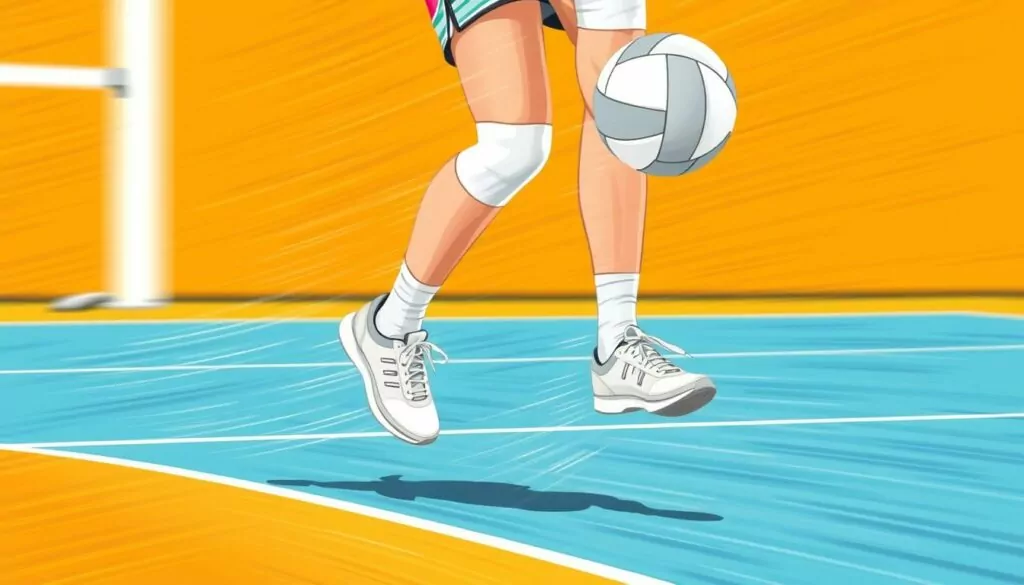
Volleyball is a fast-paced sport that needs many skills. The jump serve is one of the most complex techniques. It involves running, jumping, and hitting the ball from behind the service line. This mix of power and precision can greatly benefit players who master it.
What is a Jump Serve?
A jump serve is a special serving technique in volleyball. The player runs a few steps, jumps, and then hits the ball overhead. This method lets the player control the ball better, making it tough for the other team to return.
Benefits of Jump Serving
- It adds power and speed to the serve, making it hard for the other team to handle.
- It can lead to aces, as the jump serve is hard to return cleanly.
- It puts pressure on the opposing team’s formation and disrupts their defense.
- Learning the jump serve footwork and jump serve approach can improve your volleyball skills.
The jump serve approach usually involves three to four steps. This lets the player turn their forward momentum into upward force for a strong hit. To master this, you need physical conditioning, technical skill, and mental focus.
“The jump serve is a weapon that can change the dynamic of a volleyball match. When executed properly, it can put the opposing team on the defensive and create scoring opportunities for your team.”
Preparing Your Body for a Jump Serve
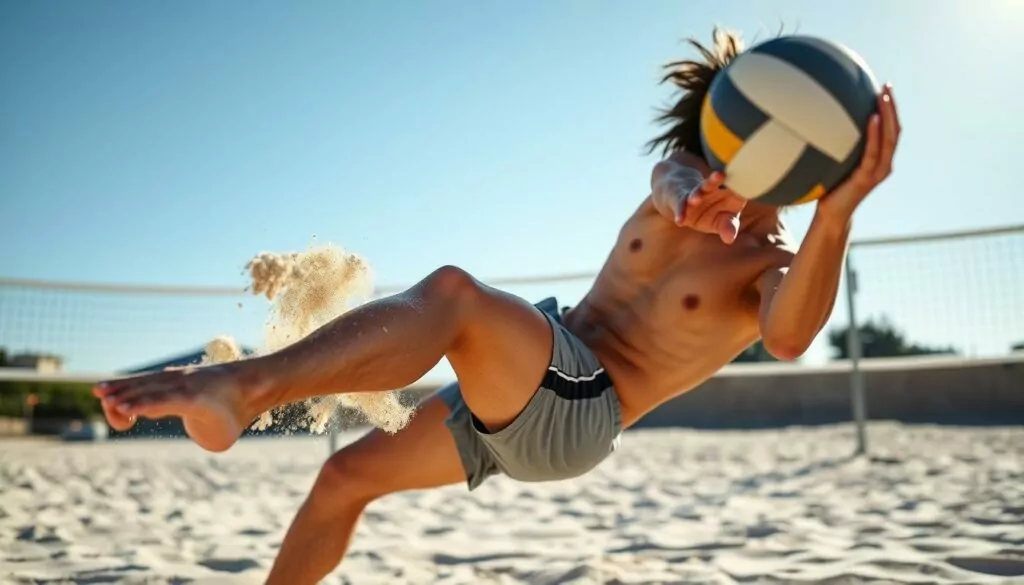
Getting your body ready for a jump serve in volleyball is key. You need strong legs, good flexibility, and a strong core. These help you serve powerfully and consistently. Let’s dive into how to prepare.
Strengthening Your Legs
Your lower body needs explosive power for a high jump and strong ball contact. Add plyometric exercises like box jumps and squat jumps to your routine. These exercises build the strength and power for a great jump serve.
Flexibility and Stretching Exercises
Being flexible in your shoulders, hips, and ankles helps your serve and keeps you injury-free. Spend time on dynamic stretching and mobility drills for these areas. Better flexibility means a smoother serve.
Importance of Core Strength
A strong core is the base for power and stability in the jump serve. Include exercises like planks and Russian twists in your training. A strong core helps you serve with more force and keeps your form right.
Focus on these physical preparation areas to improve your jump serve. Regular training and hard work will show on the court.
| Exercise | Contribution to Jump Serve |
|---|---|
| Box Jumps | Develop explosive power in the legs |
| Shoulder Mobility Drills | Enhance range of motion for serving mechanics |
| Plank Variations | Strengthen the core for stability and power |
Physical conditioning is vital for mastering the jump serve. Customize your training to meet the needs of this skill. You’ll see the benefits on the court.
Equipment Needed for Jump Serving
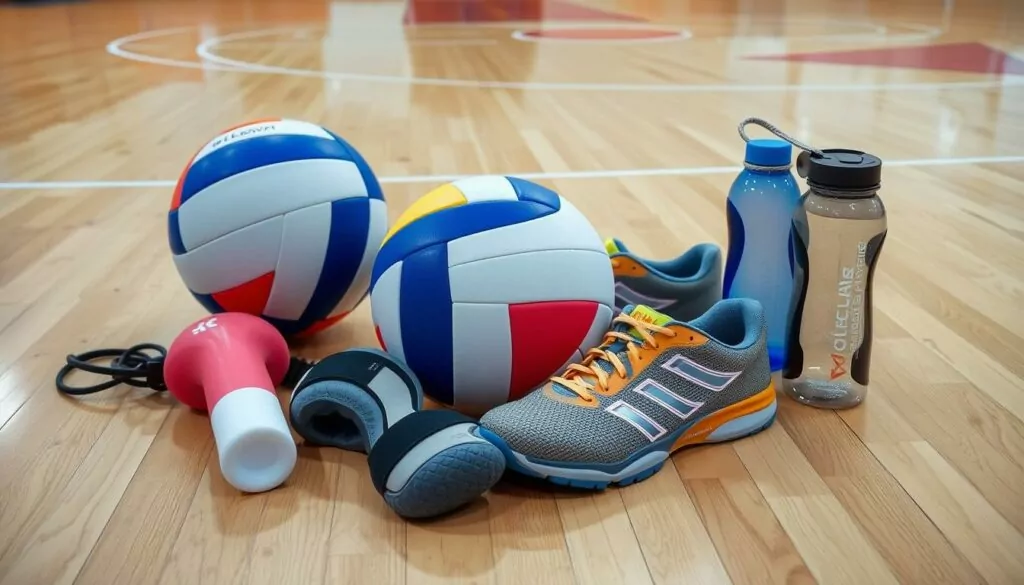
To master the jump serve in volleyball, you need the right gear. Choosing the right volleyball and supportive shoes is key. Each piece of equipment affects your success on the court.
Choosing the Right Volleyball
The volleyball for jump serving should grip well and bounce consistently. It should feel good in your hands. This lets you add spin and power to your serve.
The REN Athletics Touch-Point Accessory Head Volleyball Jump Training tool helps improve your vertical jump. It’s great for practice.
Footwear Recommendations
Good footwear is essential for jump serving. It gives you the traction and support you need. Choose volleyball-specific shoes with strong ankle support and lots of cushioning.
The Touch-Point training tool from REN Athletics helps improve your jump technique. It also boosts your explosive power.
With the right volleyball and shoes, you’ll get better at the jump serve. Your volleyball game will improve a lot.
“Incorporating the Touch-Point training tool into your routines can help you focus on jump technique, develop muscle memory, and improve explosiveness.”
Correcting Your Stance and Grip
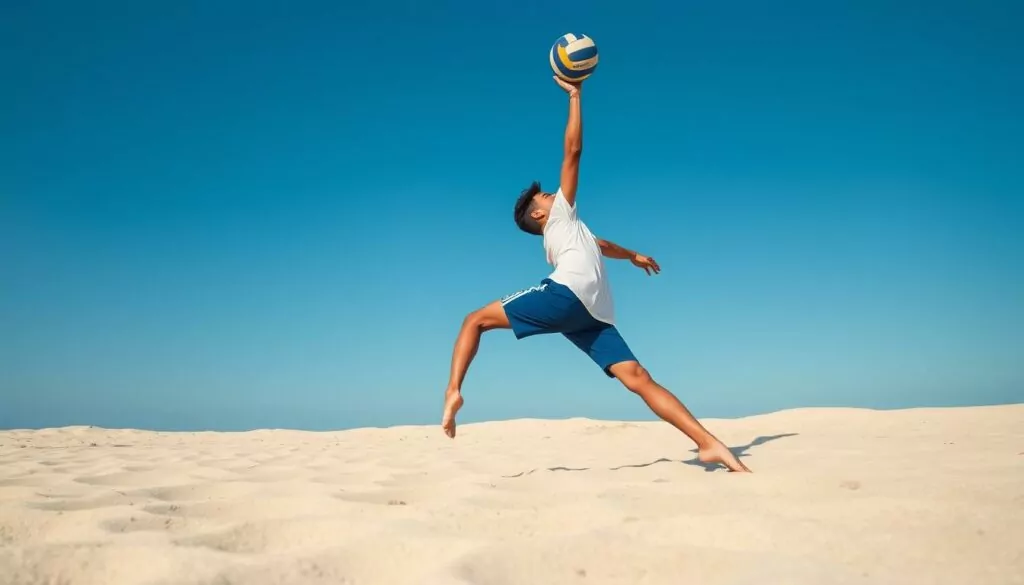
Mastering your volleyball serve begins with the basics of stance and grip. A correct volleyball serve stance is key for power, control, and consistency in your serve.
Proper Stance for Serving
To get the right stance, stand with your feet shoulder-width apart. Place your non-dominant foot slightly in front. This stance helps you stay balanced and move your weight smoothly during the serve.
Keep your knees a bit bent and stand up straight. This posture shows confidence and helps you serve better.
Holding the Volleyball Effectively
The volleyball grip is also vital for a good serve. Hold the ball with your non-hitting hand, using your fingertips. Your hitting hand should be relaxed, ready to hit the ball with an open palm.
This grip helps you control the toss and the ball’s spin or direction.
| Technique | Description | Benefits |
|---|---|---|
| Proper Serving Stance | Feet shoulder-width apart, non-dominant foot slightly in front, knees bent, upright posture | Provides balance, stability, and weight transfer for a powerful and controlled serve |
| Effective Volleyball Grip | Non-hitting hand supporting the ball with fingertips, hitting hand relaxed and ready to strike | Allows for control over the toss and desired ball trajectory |
By focusing on the volleyball serve stance and volleyball grip, you’ll build a strong foundation for serving. Practicing these basics will boost your confidence and precision at the service line.
Key Elements of a Successful Jump Serve
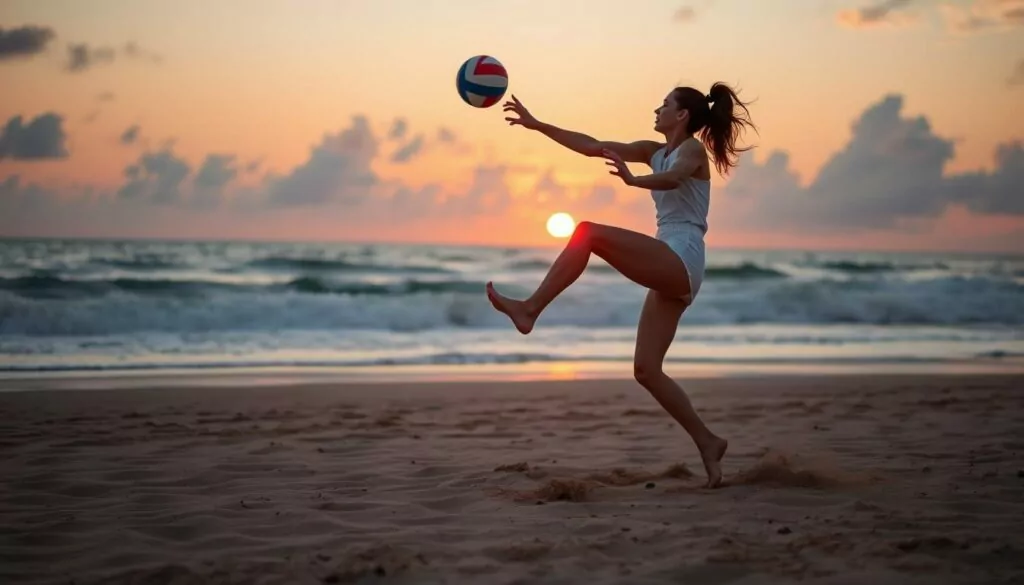
Mastering the jump serve in volleyball is all about two key things: how you approach the ball and when you jump. These elements together make a serve that can really upset your opponent’s game.
Approach to the Ball
The way you get to the ball is very important. Start with a three to four-step approach. This builds up your speed as you get closer to the serving line.
The last two steps are the most critical. They help you turn your forward motion into upward force. This lets you jump higher and hit the ball at the top of your leap.
Timing Your Jump
Getting the timing right is key for a good jump serve. Toss the ball up and a bit in front of you. This lets you swing your arm fully.
Jump to hit the ball at the highest point of your leap. This timing gives you the most power and control. You’ll hit the ball when your body is in the best position, making your serve faster and more spinny.
| Jump Serve Approach | Jump Serve Timing |
|---|---|
|
|
By getting good at your approach and timing, you’ll become a strong server. Remember, practice a lot to make your jump serve consistent and effective.
Mechanics of the Jump Serve
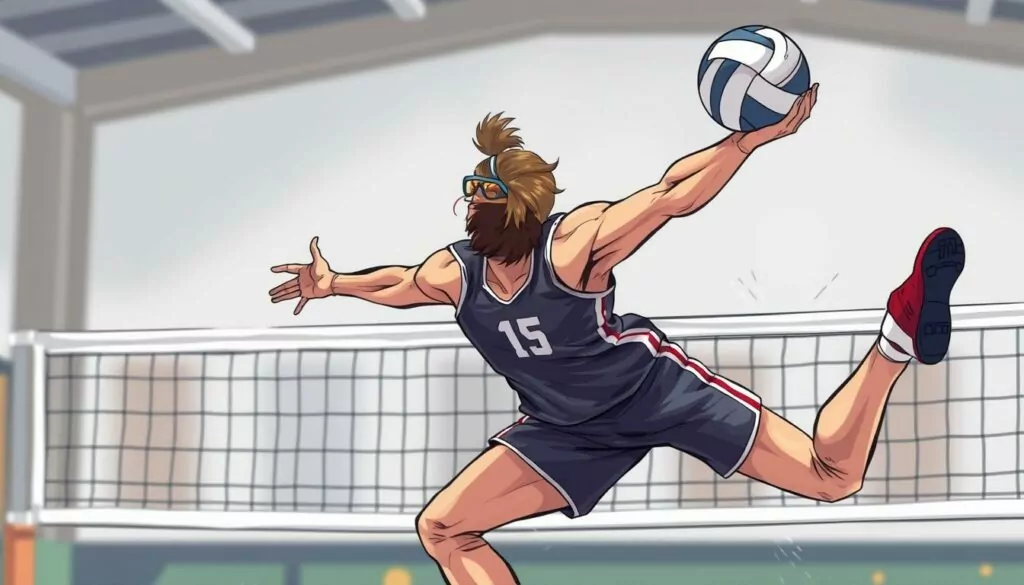
Mastering the jump serve is key for volleyball players wanting to improve. This serve combines power, control, and strategy. It’s a vital skill for any player. Let’s explore the essential parts of this serve.
How to Execute the Jump
The jump in a jump serve turns your forward momentum into vertical lift. Begin with a smooth approach, focusing on the last step before exploding upwards. Use your leg strength and core to jump high.
Arm Swing Techniques
The arm swing should be fast and whip-like, like a spike. Think of your arm as a coiled spring ready to release energy. Keep your shoulder strong and stable as you swing your arm forward. This allows your wrist and hand to snap through the ball for power and spin.
Contact Point for Maximum Power
The contact point is key for power and control in your jump serve. Hit the ball with the heel of your hand at the jump’s peak. For a straight serve, hit the ball’s center. For a curved serve, hit slightly off-center. This precise hit gives the ball the right spin and direction.
“The key to a powerful and consistent jump serve is mastering the mechanics of the jump, arm swing, and contact point. With practice and dedication, you can develop the control and versatility to make your serve a true threat on the court.”
Common Mistakes to Avoid
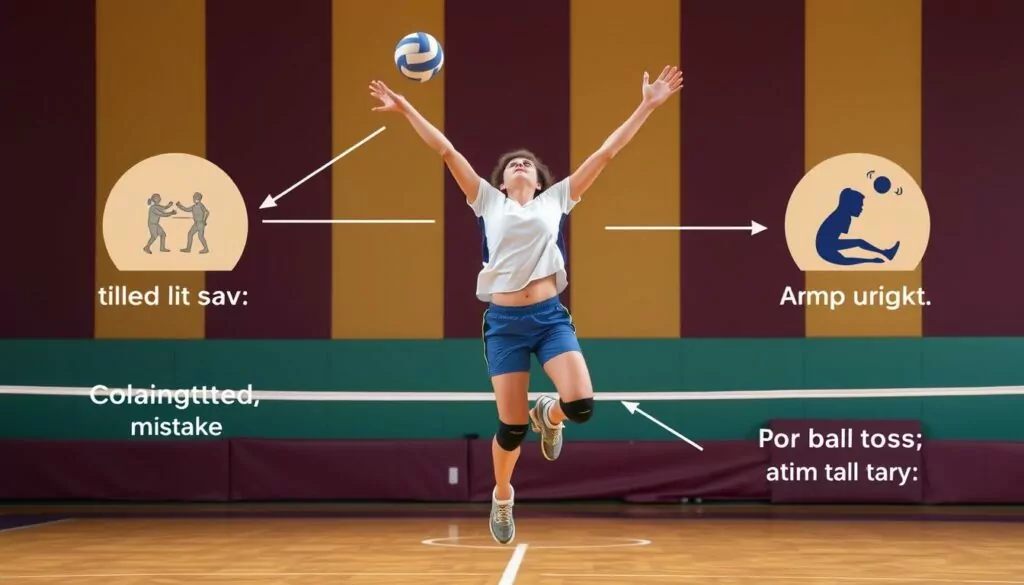
As you work to improve your jump serving, knowing common mistakes is key. These errors can slow your progress. By avoiding them, you can enhance your jump serve and become a better volleyball player.
Overthinking the Technique
Jump servers often make the mistake of overthinking their technique. Too much analysis can cause hesitation and disrupt your flow. Focus on building muscle memory through regular practice. Trust your body’s natural rhythm and let the motion flow smoothly.
Neglecting Footwork
Good footwork is vital for power and accuracy in your jump serve. Ignoring this can reduce your power and control. Make sure your footwork is consistent, with a well-timed approach and stable landing.
Other common mistakes include inconsistent ball tosses, lacking leg drive, poor contact points, and insufficient follow-through. By fixing these issues and using specific drills, you can improve your jump serve and become a more effective server.
Mastering the jump serve requires time and effort. Stay focused, practice hard, and be patient with yourself as you work to improve your jump serve. With the right techniques and mindset, you can boost your game and become a threat on the serving line.
Drills to Practice Your Jump Serve
Mastering the jump serve in volleyball takes hard work and dedication. Adding different drills to your routine can improve your technique and timing. It also helps build muscle memory for a great jump serve. Let’s look at some drills to boost your serving skills.
Solo Drills for Technique Improvement
Practicing alone is a great way to improve your jump serve. These drills let you focus on key parts of the serve, like tossing the ball and jumping. Some effective solo drills include:
- Toss and catch exercises to develop a consistent ball toss
- Wall serving drills to refine your form and follow-through
- Approach and catch drills to synchronize your movements
- Target practice to improve your accuracy and placement
Partner Drills to Enhance Timing
Practicing with a partner can really help improve your jump serve. Partner drills mimic game situations, helping you serve under pressure. They also help you get better at timing with a receiver. Here are some partner drills to try:
- “X Marks the Spot” drill: Have your partner stand in a specific target area and serve to them, focusing on accuracy and placement.
- 10-foot line challenge: Serve the ball back and forth across a 10-foot line, focusing on a straight, powerful follow-through.
- Field goal drill: Serve the ball through a decreasing number of net squares or pool noodle obstacles, challenging your precision.
Being consistent is key when practicing your jump serve. Do drills that focus on repetition and muscle memory, like serving a set number of balls to the same spot. By sticking to regular jump serve practice and volleyball serve drills, you’ll get the confidence and skills for a strong jump serve in games.
“The jump serve is a dynamic and powerful technique that can be a game-changer in volleyball. Mastering the mechanics and timing through consistent practice is key for any serious player.”
Building Confidence in Your Serve
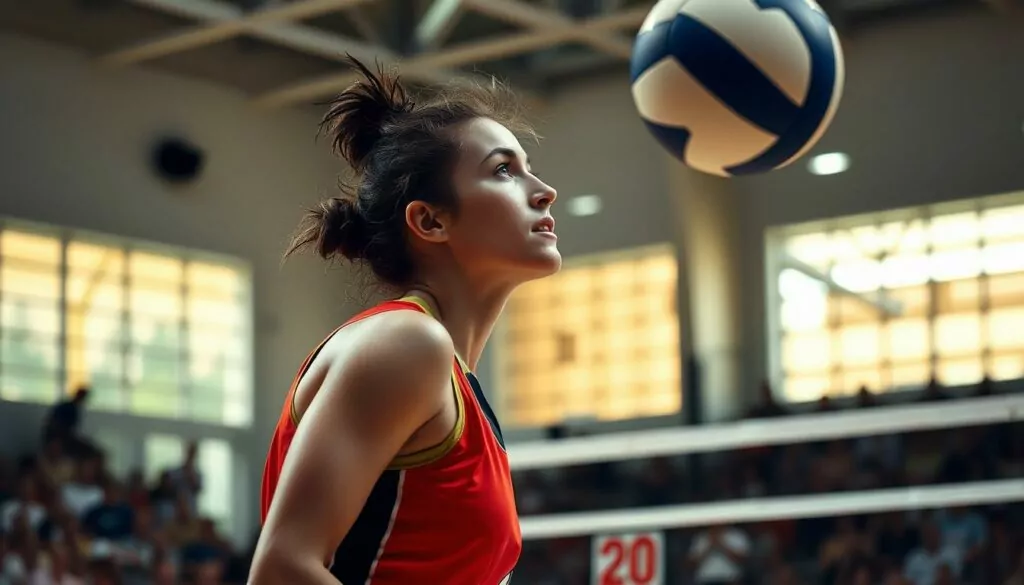
Confidence is key for a successful jump serve in volleyball. Mastering mental preparation and visualization can boost your serve. You’ll deliver powerful shots that keep opponents guessing.
Mental Preparation Techniques
Positive self-talk is a great way to build serve confidence. Before serving, take deep breaths and recall your strengths and past wins. Imagine the ball flying over the net and landing where you want it.
This mental rehearsal keeps you focused and calm during the serve.
Visualization Strategies
Visualization is a strong tool for volleyball players. Picture yourself serving perfectly every day. Think about your approach, ball contact, and shot trajectory.
The clearer your mental images, the better your body will perform. A consistent pre-serve routine also boosts confidence and focus. It could be a set of movements or encouraging words.
Building serve confidence takes time and practice. You need to adapt and stay poised under pressure. With the right mental prep and visualization, you’ll serve with confidence and precision soon.
Incorporating Spin into Your Serve
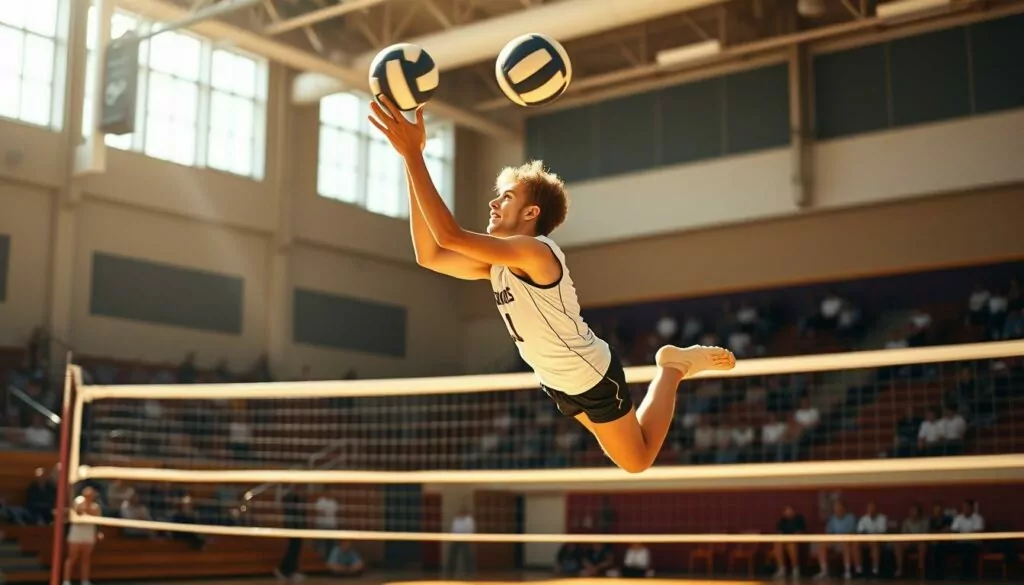
In competitive volleyball, the jump serve has become a game-changer. Adding spin makes it more complex and effective. Learning topspin and slice serves can give you an edge, making it hard for opponents to return the ball.
Understanding Topspin
The topspin jump serve hits the ball up, making it drop fast and erratically over the net. This makes it tough for the other team to control, leading to mistakes. Mastering this serve keeps your opponents guessing and opens up scoring chances for you.
Benefits of Slice Serve
The slice serve uses side and topspin for a curved path. It confuses the other team, making them adjust their position and footwork. This serve is great for targeting specific spots on the court and finding weaknesses in the opposing team.
Adding these spin techniques to your serve needs practice and understanding ball control. Mastering topspin and slice serves can make you a strong server. You’ll be able to disrupt the other team’s offense and create chances for your team.
“A strong serve can potentially force a poor pass or a free ball from the opposing team, giving your team the upper hand in the rally.”
Analyzing Your Performance
To get better at your volleyball jump serve, first, you need to know where you stand. Video analysis is a great tool for this. It lets you see your technique, approach, and how the ball flies. By watching your serves from different angles, you can spot what needs work.
Getting advice from coaches is also super helpful. They can tell you about your serving style, strategy, and how to get better. Coaches can even compare your skills to those of pros, showing you how to improve.
Video Analysis Techniques
Slow-motion videos are key for focusing on your jump serve. Look at your approach, jump timing, and where you hit the ball. Check your footwork, arm swing, and body position to make sure you’re doing it right. Seeing your serves side-by-side can help you find and fix any mistakes.
Getting Feedback from Coaches
Coaches’ feedback is essential for getting better at volleyball, and jump serving in particular. They can point out what you’re doing well and what needs work. They’ll suggest drills to fix any issues and help you make a plan to improve your serve.
| Volleyball Performance Analysis | Serve Improvement |
|---|---|
|
|
By using video analysis and listening to coaches, you can learn a lot about your volleyball game. This knowledge will help you improve your jump serve. Regularly checking and refining your skills is the way to get better on the court.
Adaptations for Different Skill Levels
Mastering the jump serve in volleyball requires a tailored approach. Beginners and intermediate players have specific strategies to follow. These help you improve your skills.
Techniques for Beginners
Beginners should first master the basic overhand serve. Start with a stationary serve, then add the approach and jump as you get better. A strong jump serve starts with a solid overhand serve.
Tips for Intermediate Players
Intermediate players should focus on refining the jump serve. Work on your approach, jump height, and spin types like topspin or slice. Use drills to improve precision and power.
Understanding the needs of beginners and intermediate players helps you plan your jump serving progress. This way, you can become a well-rounded volleyball athlete.
Jump Serving in Game Situations
In a volleyball game, your jump serve is a key tool. It’s important to read the opponent’s defense and adjust your serve. Look at their defense to find weak spots and aim for them.
Reading the Opponent’s Defense
Before serving, study the opponent’s setup. Are they ready for a deep serve or a quick float serve? Change your serve to challenge them and keep them guessing.
Serving Under Pressure
Being able to serve well under pressure shows true skill. Practice serving in game-like situations. This builds your mental strength and confidence for when it matters most.
| Technique | Advantage | Disadvantage |
|---|---|---|
| Jump Float Serve | Flat trajectory, harder to receive | Requires precise control and timing |
| Jump Topspin Serve | Increased power and spin | Harder to control and target specific areas |
| Jump Slice Serve | Angled trajectory, creates unpredictable movement | Demands more skill and practice to master |
Learning different jump serves makes you flexible and unpredictable. Practice often, stay focused, and adapt to the game’s flow. This is how you serve well in games.
“Serving is the most important skill in volleyball. The jump serve is a game-changer that can swing the momentum in your favor.” – John Doe, Volleyball Coach
Injuries and Safety Considerations
Volleyball is a dynamic sport that requires explosive movements, like jump serving. This can lead to injuries if not done right. It’s important to know the common injuries and how to prevent them to enjoy the game safely.
Common Injuries from Jump Serving
Jump serving can strain the shoulder and wrist joints because it’s repetitive. Common injuries include rotator cuff strains, shoulder impingement, and wrist sprains. These happen due to the high-impact serve, poor technique, or overuse.
Preventive Measures
- Start with a good warm-up that stretches and activates muscles for jump serving.
- Do strength training to build muscles around the shoulder and wrist joints.
- Focus on proper serving technique for a smooth motion and less strain.
- Limit jump serves in practice and matches to avoid overuse injuries.
- Take breaks if you feel any pain or discomfort.
- Get medical advice if you have any ongoing issues or injuries from jump serving.
By focusing on volleyball injury prevention and using safe serving techniques, you can perform better while reducing injury risks. Listen to your body and balance training to enjoy volleyball for a long time.
| Injury | Prevalence | Risk Factors | Preventive Measures |
|---|---|---|---|
| Rotator Cuff Strain | Common | Repeated overhead serving motions | Strengthen shoulder muscles, proper serving technique |
| Wrist Sprain | Frequent | Impact on landing, poor wrist positioning | Improve wrist flexibility, use wrist guards |
| Ankle Sprain | Frequent | Jumping, landing, and sudden changes of direction | Wear appropriate footwear, strengthen ankle muscles |
| Finger Injuries | Common | Setting, blocking, and hitting activities | Use protective finger guards, proper technique |
Developing a Consistent Serving Routine
As a volleyball player, it’s key to have a solid serving routine. This means delivering accurate and powerful serves. A pre-serve ritual helps focus your mind and body, boosting your chances of a great volleyball serve routine.
Establishing a Pre-Serve Ritual
To make your serving routine consistent, add a few key steps to your pre-serve ritual. You might take deep breaths, picture the perfect serve, or follow a ball-bouncing pattern. These small actions help you get into the right rhythm and focus before serving.
Importance of Repetition
Repetition is vital for mastering any volleyball skill, including serving. Spend part of your training sessions on consistent serving practice. Recreational players, try arriving early or staying late to practice more. Regular practice builds muscle memory and control, leading to better serves.
| Technique | Description | Benefits |
|---|---|---|
| Toss the ball in front of your serving shoulder | Release the ball slightly in front of your serving shoulder, allowing for a smooth and natural arm swing. | Promotes consistent ball contact and serves with more control. |
| Keep your elbow high and back | Maintain a high elbow position throughout your arm swing, keeping your elbow back and your wrist firm. | Generates more power and spin on the serve. |
| Contact the middle of the ball | Make contact with the ball in the center, using the middle of your hand. | Ensures a clean, solid hit for improved accuracy and consistency. |
| Follow through on your arm swing | Complete your arm swing by following through with your serving hand, allowing for maximum power and control. | Helps maintain proper technique and encourages a smooth, consistent motion. |
Using these techniques in your volleyball serve routine can make your serve consistent and reliable. This is key for success on the court.
“Consistency is the key to mastering any volleyball skill, and serving is no exception. Dedicated practice and a well-established pre-serve routine can help you become a more confident and effective server.”
Learning from the Pros
Want to get better at volleyball? Look at how elite jump servers play. Tri Bourne, a top beach volleyball player, is known for his amazing jump serve. Watch how he moves, tosses the ball, and hits it with power and spin.
These skills make the game tough for the other team. They show what it takes to be a pro at serving.
Studying Elite Jump Servers
Watching players like Tri Bourne can teach you a lot. Focus on their approach, how they stand, and when they hit the ball. Learning these basics is key to improving your serving skills.
Key Takeaways from Star Players
- Consistent toss: Top jump servers always toss the ball the same way. This helps them hit the ball with the right power and place.
- Explosive approach: The best jump servers start their jump with a lot of power. They use their legs and core to send the ball flying.
- Strategic serve selection: Great players change their serves based on the game and who they’re playing. They use different serves to keep the other team guessing.
By watching how elite jump servers play, you can learn to serve better. Use what you learn to improve your game and become a stronger server.
“The jump serve is a game-changer in volleyball. Mastering it requires precision, power, and the ability to adapt to different situations. Learning from the pros can be a game-changer.”
Staying Updated on New Techniques
I love volleyball and always want to get better. Learning new serving techniques is key. I find that going to volleyball clinics and workshops is great. There, I learn from top coaches and players.
Joining Volleyball Clinics
Volleyball clinics are a big help for me. They have demos, drills, and feedback from experts. I get to learn new strategies, find what I need to work on, and get coaching to improve.
Online Resources for Continuous Learning
Online resources are also important for me. YouTube has lots of volleyball tutorials and training. They cover everything from basic to advanced serves. By using these resources, I keep learning and adding new skills to my practice.
